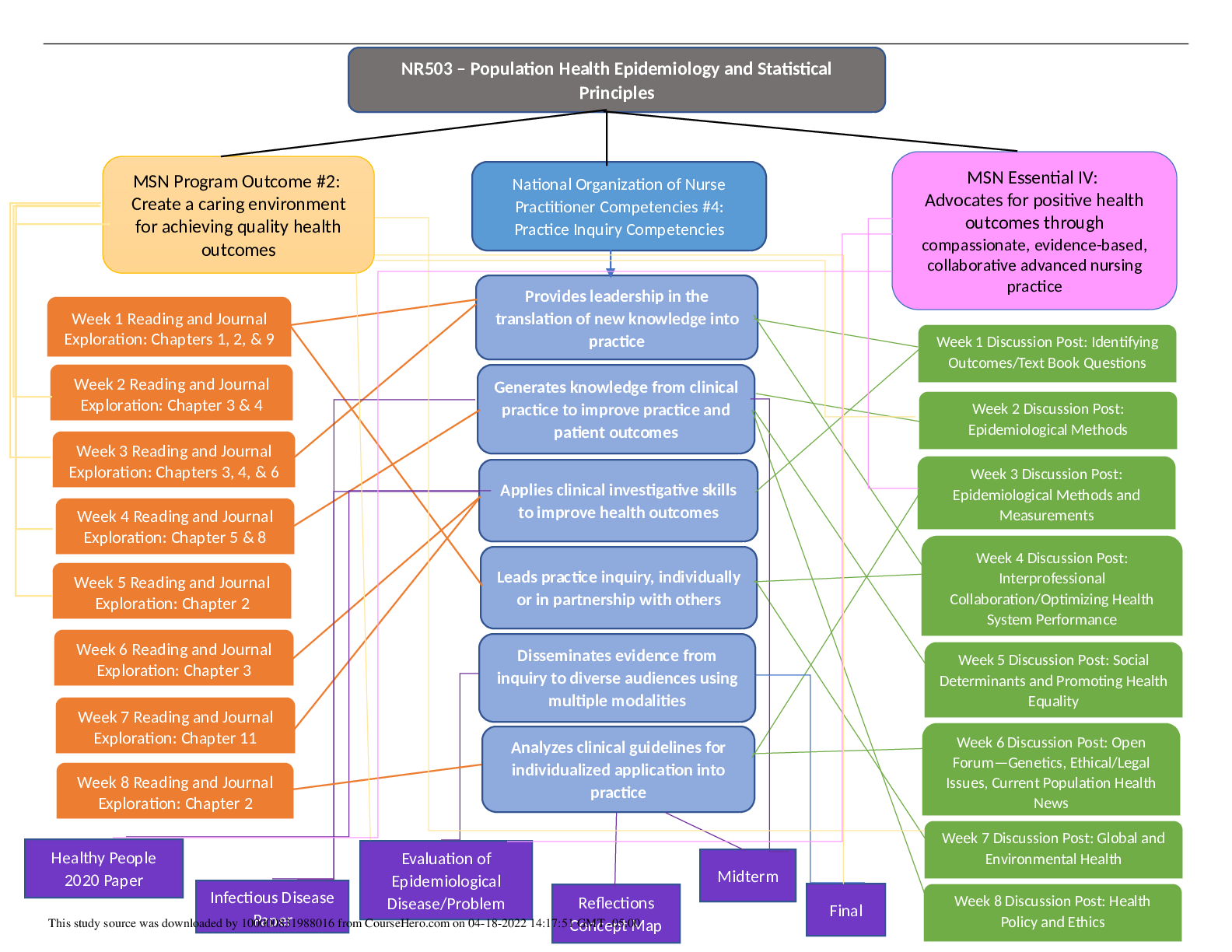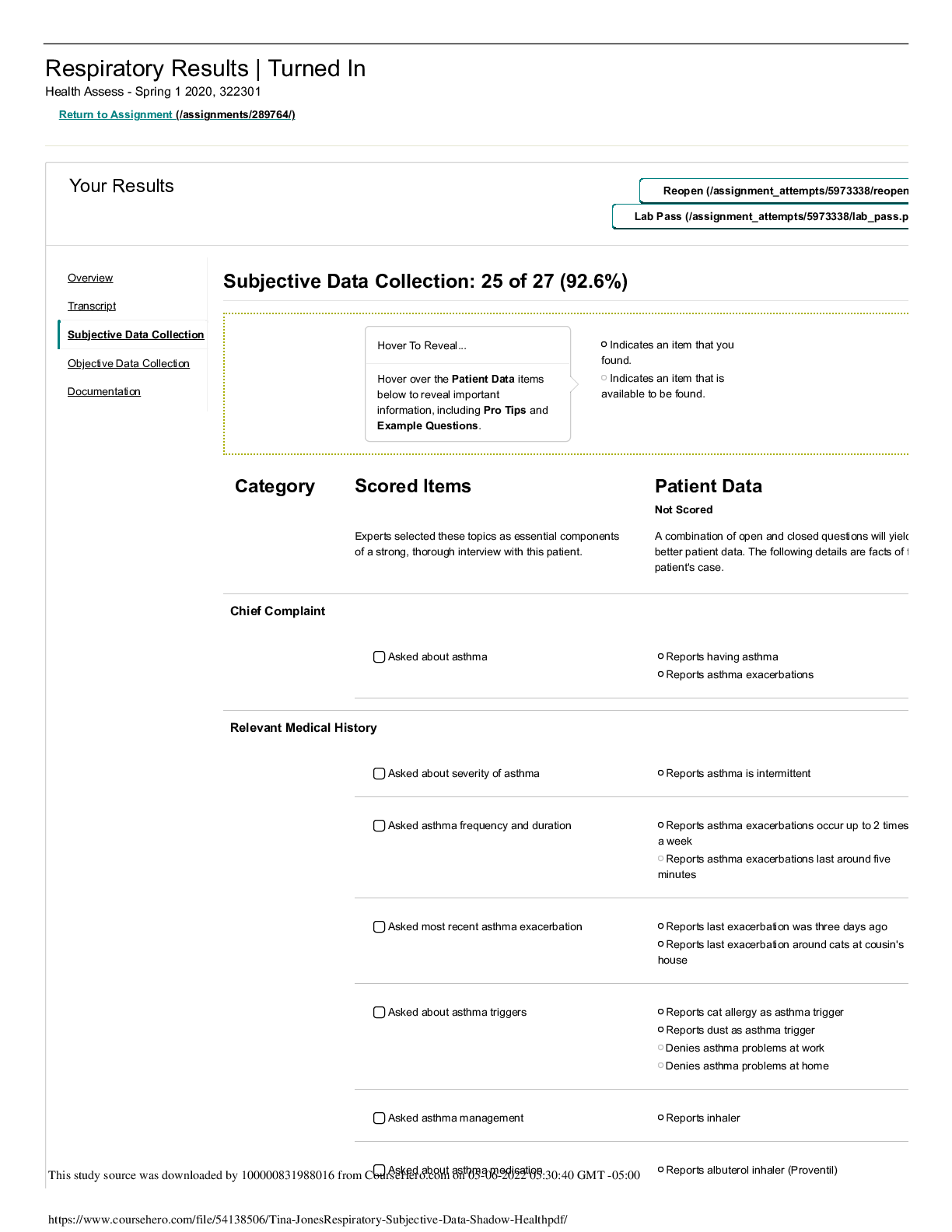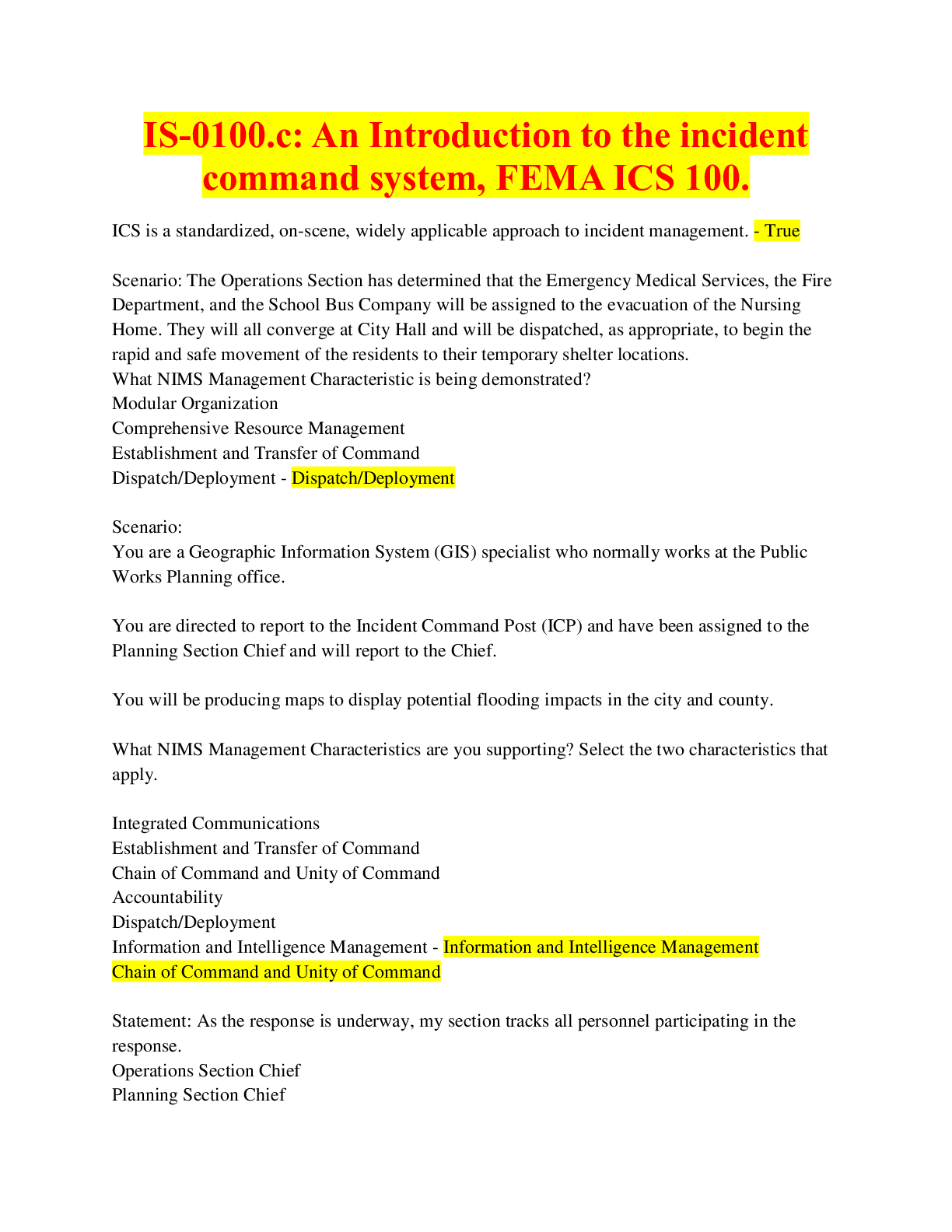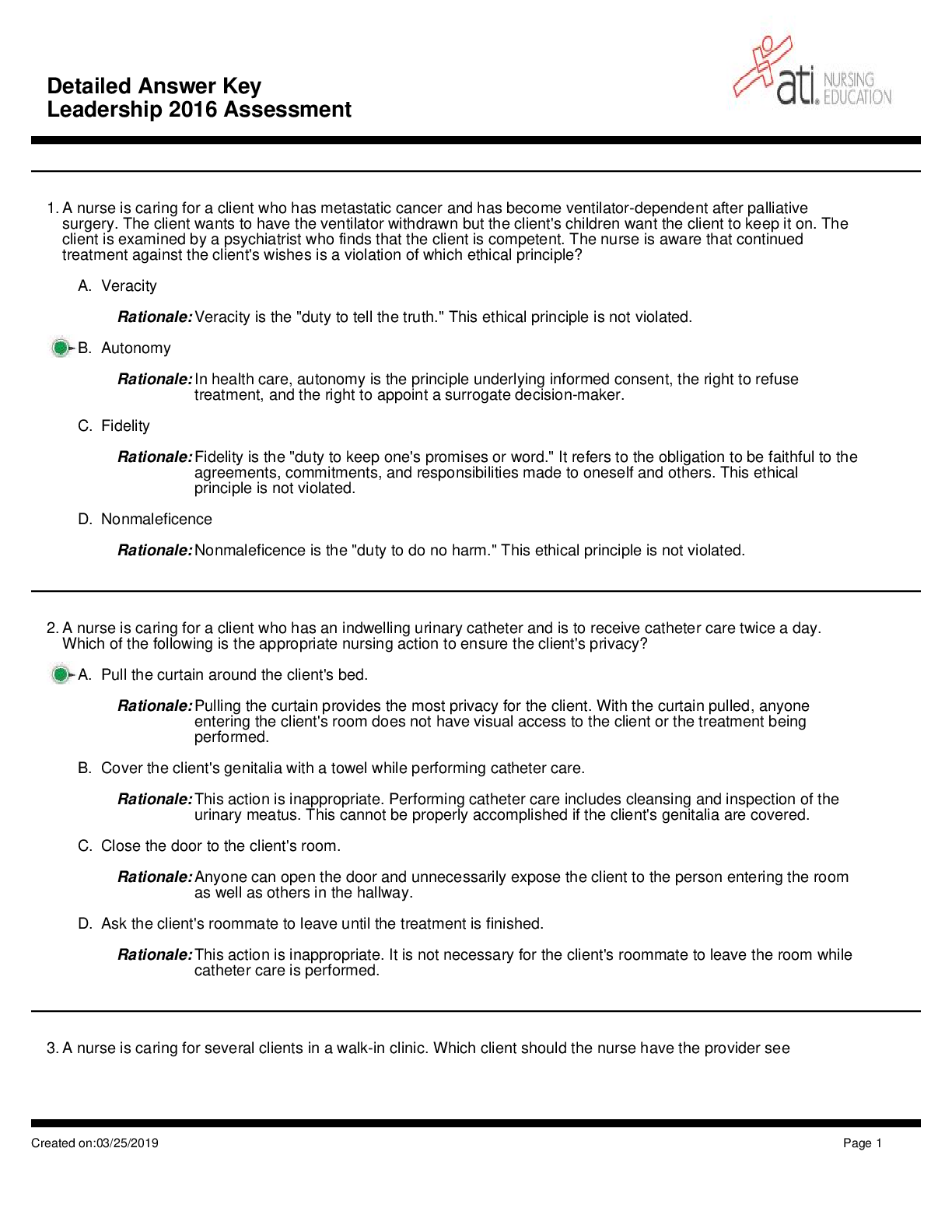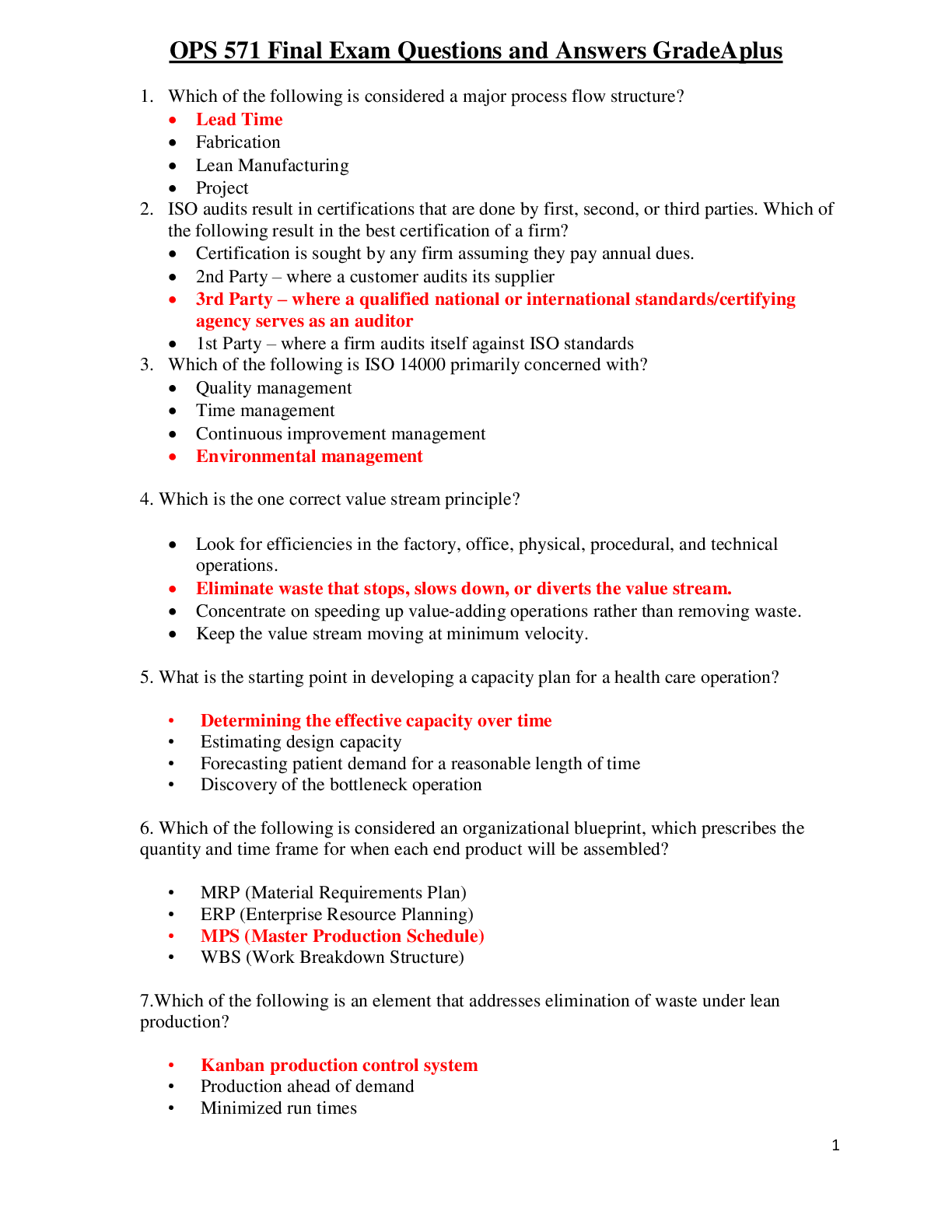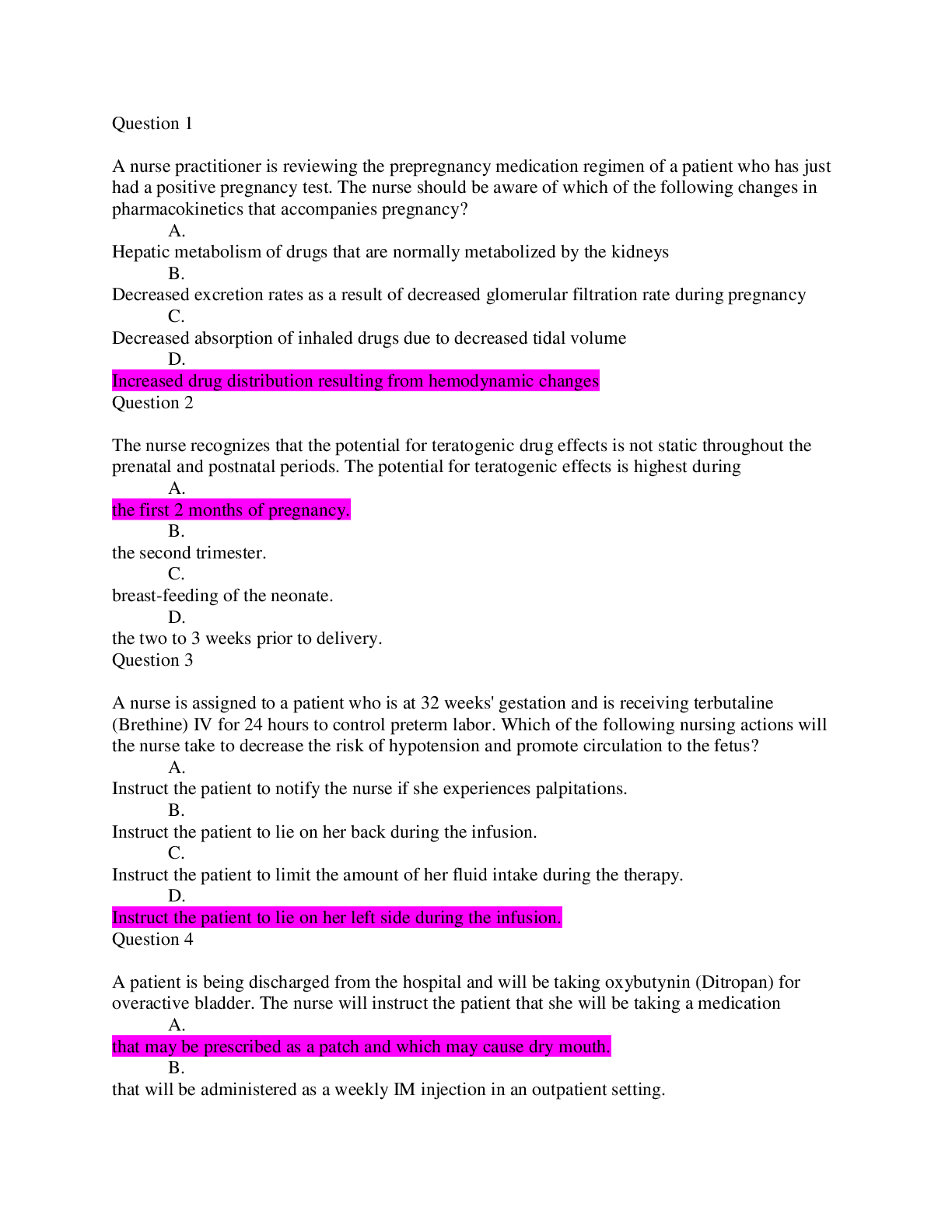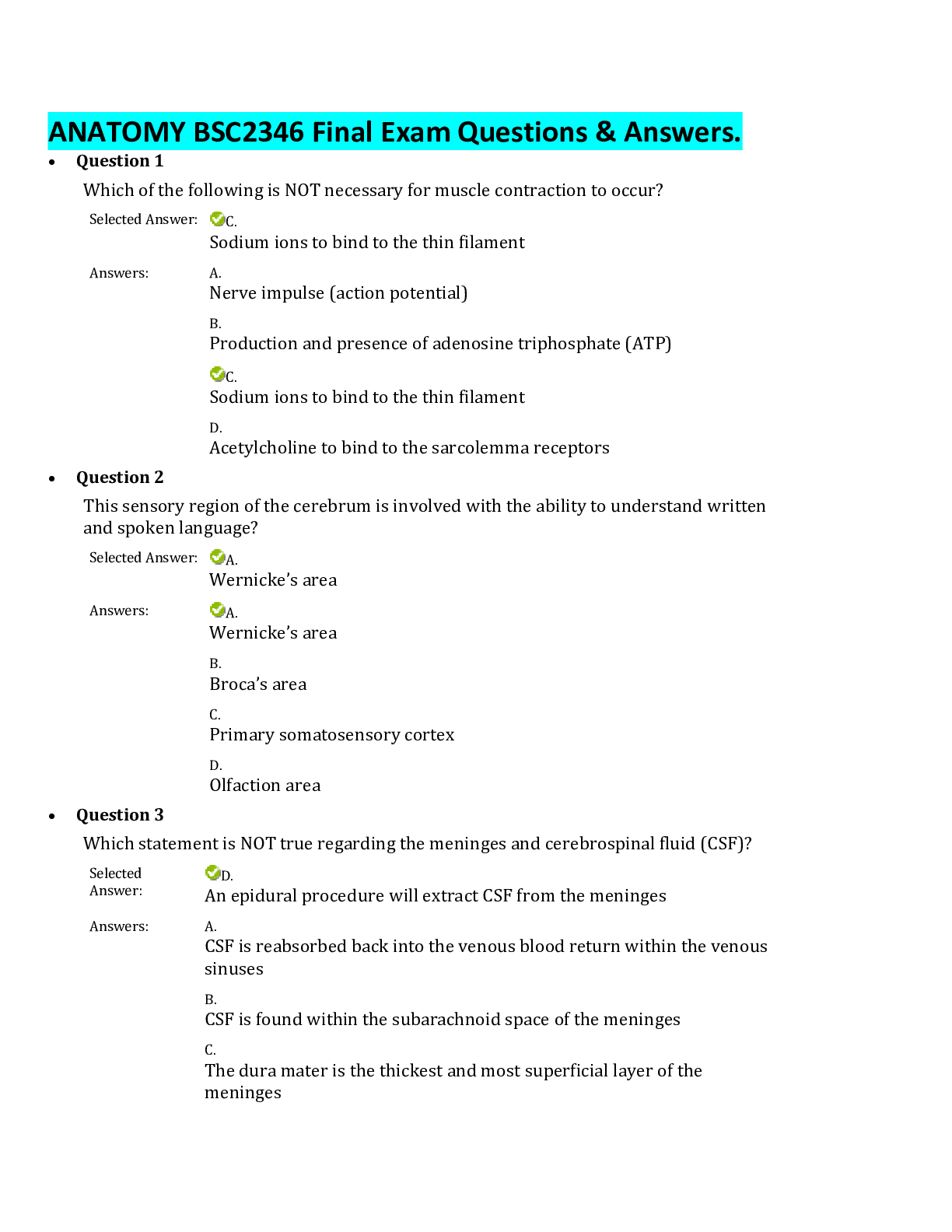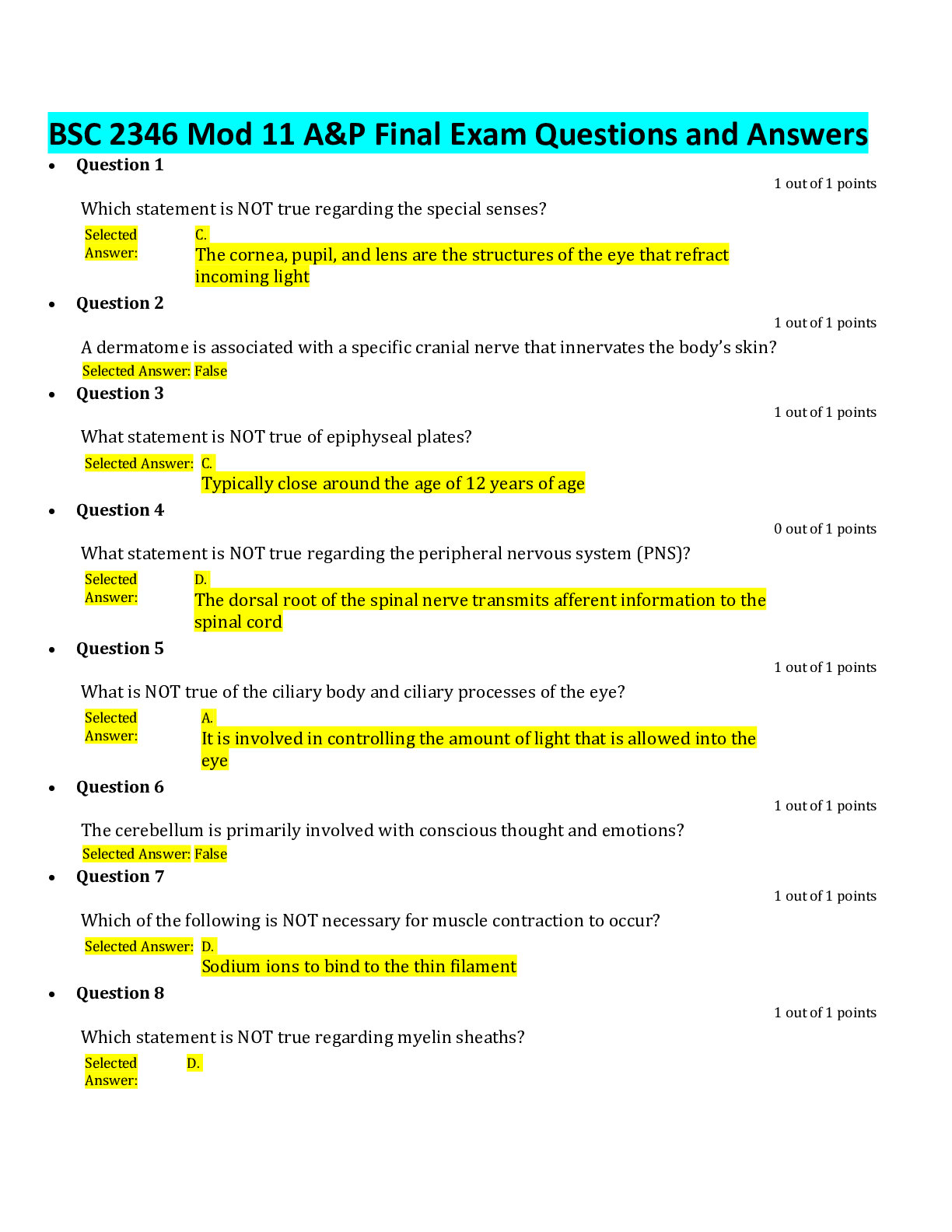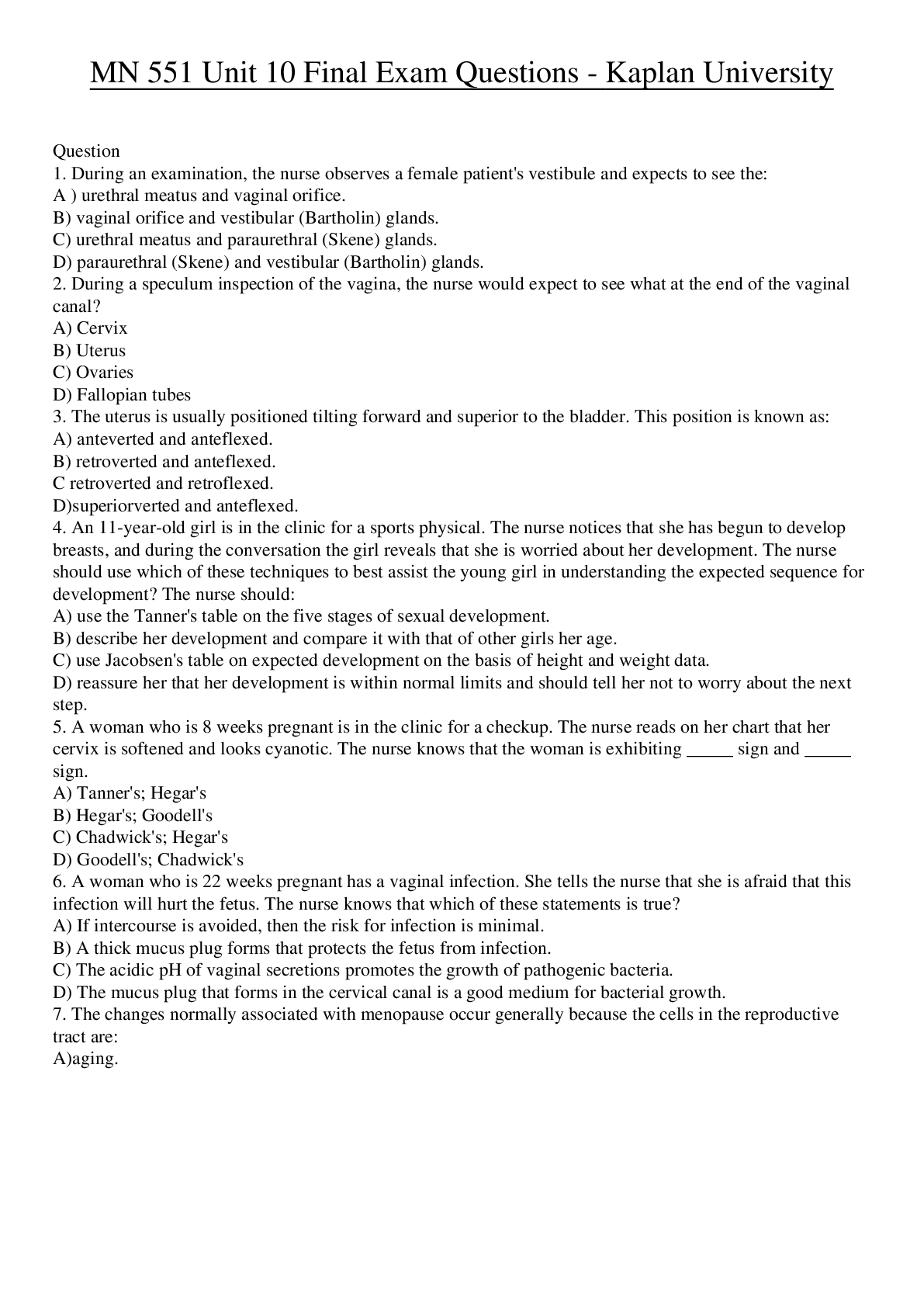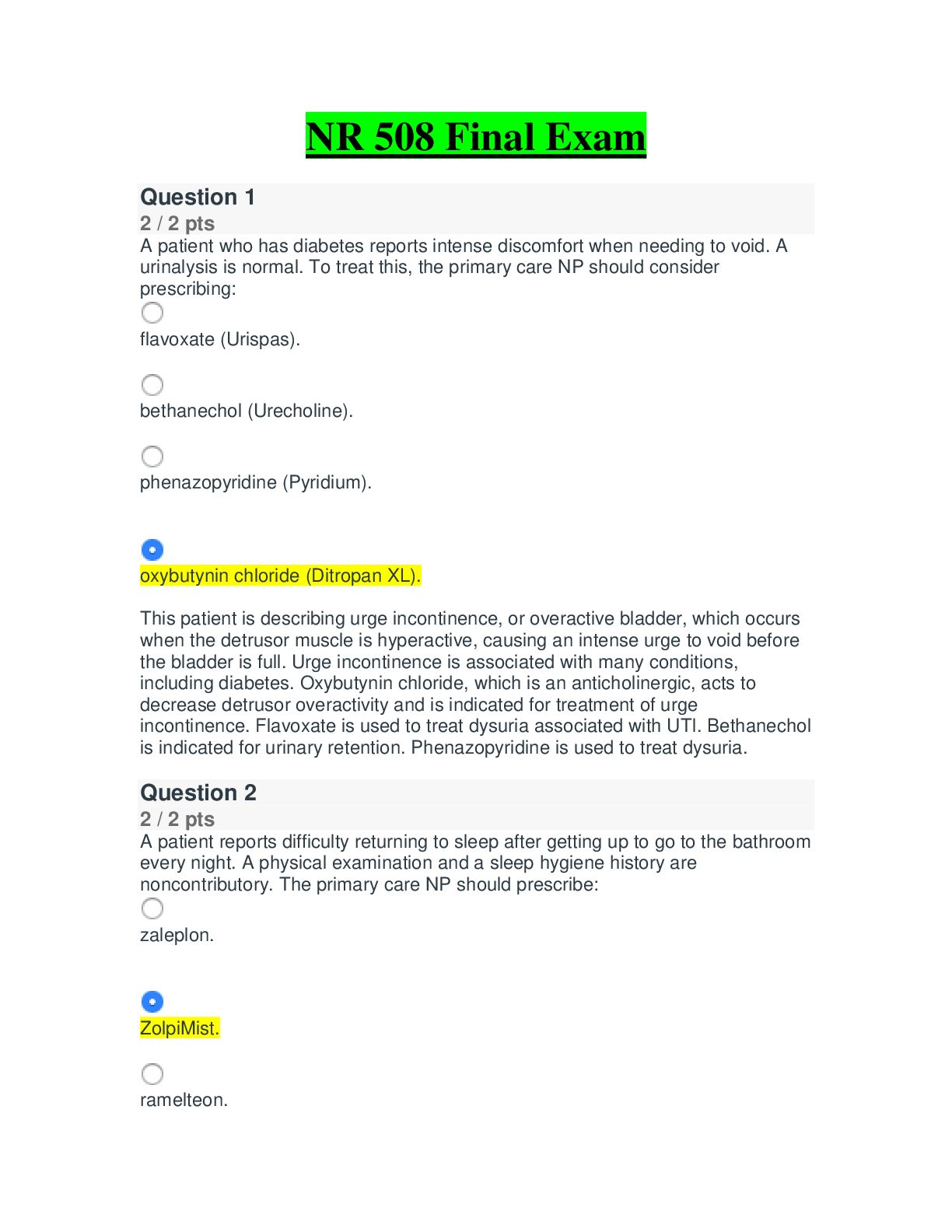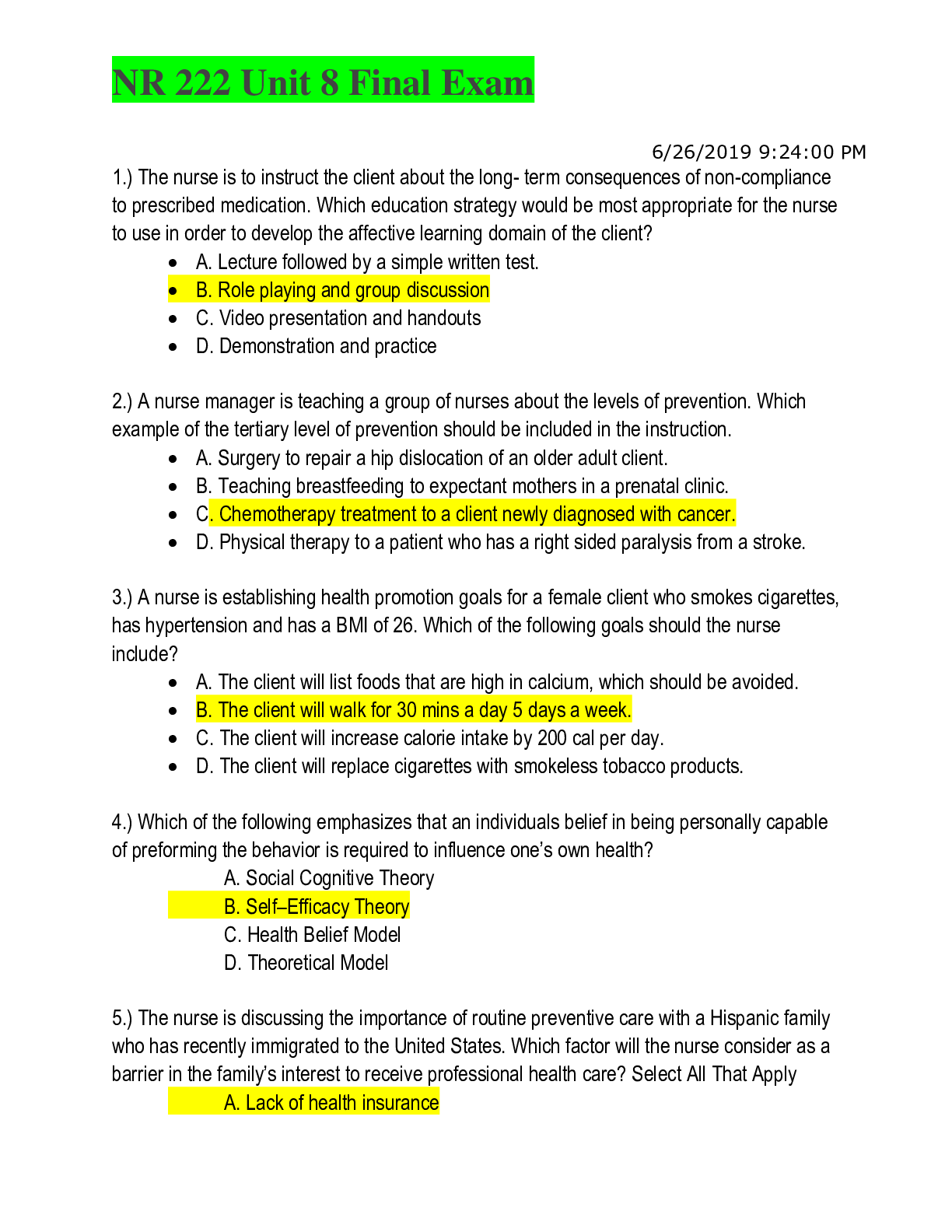NURS 372 Final Exam Questions & Answers
Document Content and Description Below
NURS 372 Final Exam Questions & Answers-The following are asthma symptoms that may present themselves SATA: A. Crackles heard bilaterally on lung bases on auscultation B. Daytime symptoms of wheezi... ng, dyspnea, coughing present more than twice weekly C. Waking from night sleep with symptoms of wheezing, dyspnea, coughing D. Dyspnea on exertion with activity E. Reliever (rescue) drug needed more than twice weekly F. Activity limited or stopped by symptoms more than twice weekly - B, C, E, F During an acute asthma exacerbation, wheezing can be heard on ______ - exhalation The following conditions may cause patients to have a barrel chest or increased anteroposterior (AP) diameter of the chest SATA: A. Bronchitis B. COPD C. Asthma D. Pneumonia E. Cystic Fibrosis - B, C Which tests can be used to assess for asthma? Select all that apply. 1) Blood gas 2) Basic Metabolic Panel 3) Prothrombin Time 4) Immunoglobulin E level 5) Pulmonary Function Test 6) Eosinophil level - 1, 4, 5, 6 The most accurate tests for measuring airflow in asthma are _____ - pulmonary function tests (PFTs) Provide patient teaching on how to properly manage asthma - Avoid potential environmental asthma such as smoke, dust, mold, weather changes, etc. Avoid drugs that may trigger asthma such as aspirin, NSAIDs, and beta blockers avoid food that has been prepared with MSG or metabisulfate For exercise, use the reliever inhaler 30 min before workout to reduce bronchospasm Wash all bedding with hot water to destroy dust mites Get adequate rest and sleep For the patient with hx of asthma, seek immediate emergency care if you experience: - Gray or blue fingertips or lips Difficulty breathing, walking, or talking Retractions of the neck, chest, or ribs Nasal flaring Failure of drugs to control worsening symptoms Primarily used as a fast-acting reliever (rescue) drug; Induces rapid bronchodilation through relaxing beta 2 receptors in lungs; Given to improve bronchospasm within 5-15 min; can control symptoms for up to 6 hours - Short acting Beta Agonists (SABA) Examples of short acting beta agonist medications - Levalbuterol (Xenopex) Albuterol Patient education for SABA drugs - Carry drug on you at all times to reduce a chance of life-threatening bronchoconstriction. Patient needs to monitor heart rate because excessive use of albuterol causes tachycardia When taking this drug with any other inhaled drugs, teach patient to use them at least 5 minutes before the other inhaled drugs Use the correct technique for MDI or DPR to ensure the drug reaches the site of action Causes bronchodilation through relaxing bronchiolar smooth muscle by binding to and activating pulmonary beta2 receptors. Given for bronchospasms but onset slow with long duration (within 15-30mins; helps control symptoms for approx. 12 hrs). Primary use is prevention of an asthma attack - Long acting Beta 2 Agonists (LABA) Examples of long acting beta 2 receptors - Salmeterol (inhaled drug); Indacaterol (COPD only) (inhaled drug); Formoterol Arformoterol (COPD only) Patient education for LABA drugs - Do not use these drugs as reliever drugs because they have a slow onset of action and do not relieve acute symptoms. Teach patient the correct technique for using the MDI or DPI to ensure that the drug reaches the site of action Should never be prescribed as the only drug therapy for asthma and are not to be used during an acute asthma attack or bronchospasm. Use daily even when no asthma symptoms are present Disrupt production pathways of inflammatory mediators. The main purpose is to prevent an asthma attack caused by inflammation or allergies (controller drug). - Corticosteroids Examples of corticosteroids - Fluticasone (MDI inhaled drug); Beclomethasone (MDI inhaled drug); Budesonide (MDI inhaled drug) Patient education for Corticosteroid drugs (inhaler and PO) - Use the drug daily, even when no symptoms are present, because maximum effectiveness requires continued use for 48-72 hours and depends on regular use. Do not use these drugs as reliever drugs because they have a slow onset of action and do not relieve acute symptoms. Use MDI to ensure the drug reaches the site of action. Teach patient to avoid anyone who has an upper respiratory infection because the drug reduces all protective inflammatory responses, increasing the risk for infection Teach patient to take drug with food to help reduce the side effect of GI ulceration. Teach patient not to suddenly stop taking the drug for any reason because the drug suppresses adrenal production of corticosteroids, which are essential for life. Teach patient to avoid activities that lead to injury because blood vessels become more fragile, leading to bruising and petechiae. Why is it important for patients taking corticosteroids to practice good oral care ? - use good mouth care and check mouth daily for lesions or drainage because these drugs reduce local immunity and increase the risk for local infections, especially Candida albicans (yeast) Blocks the leukotriene receptor, preventing the inflammatory mediator from stimulating inflammation. Purpose is to prevent asthma attack triggered by inflammation or allergens. - Leukotriene Modifiers Patient education for Montelukast drugs - use the drug daily, even when no symptoms are present, because maximum effectiveness requires continued use for 48-72 hours and depends on regular use. Do not decrease the dose of or stop taking any other asthma drugs unless instructed by the health care professional because this drug is for long-term asthma control and does not replace other drugs, especially corticosteroids and reliever (rescue) drugs. Risk factors of COPD - Cigarette smoking, environmental factors, genetics, asthma, Alpha 1 -antitrypsin deficiency, hx of asthma Normal ABGs - pH: 7.35 - 7.45 PaCO2: 35 - 45 HCO3: 22 - 26 PaO2: 80 - 100 T/F: Ensure that no open flames (e.g., smoking, fireplaces, burning candles) or other combustion hazards are in rooms where oxygen is in use. - True a severe, life-threatening acute episode of airway obstruction that intensifies once it begins and often does not respond to usual therapy; If the condition is not reversed, the patient may develop pneumothorax and cardiac or respiratory arrest. - Status Asthmaticus Intervention for status asthmaticus - IV fluids, potent systemic bronchodilators, steroids, epinephrine, and oxygen are given immediately to reverse the condition. a destructive problem of lung elastic tissue that reduces its ability to recoil after stretching, leading to hyperinflation of the lung - Emphysema a collection of lower airway disorders that interfere with airflow and gas exchange . - COPD [Show More]
Last updated: 4 months ago
Preview 1 out of 33 pages
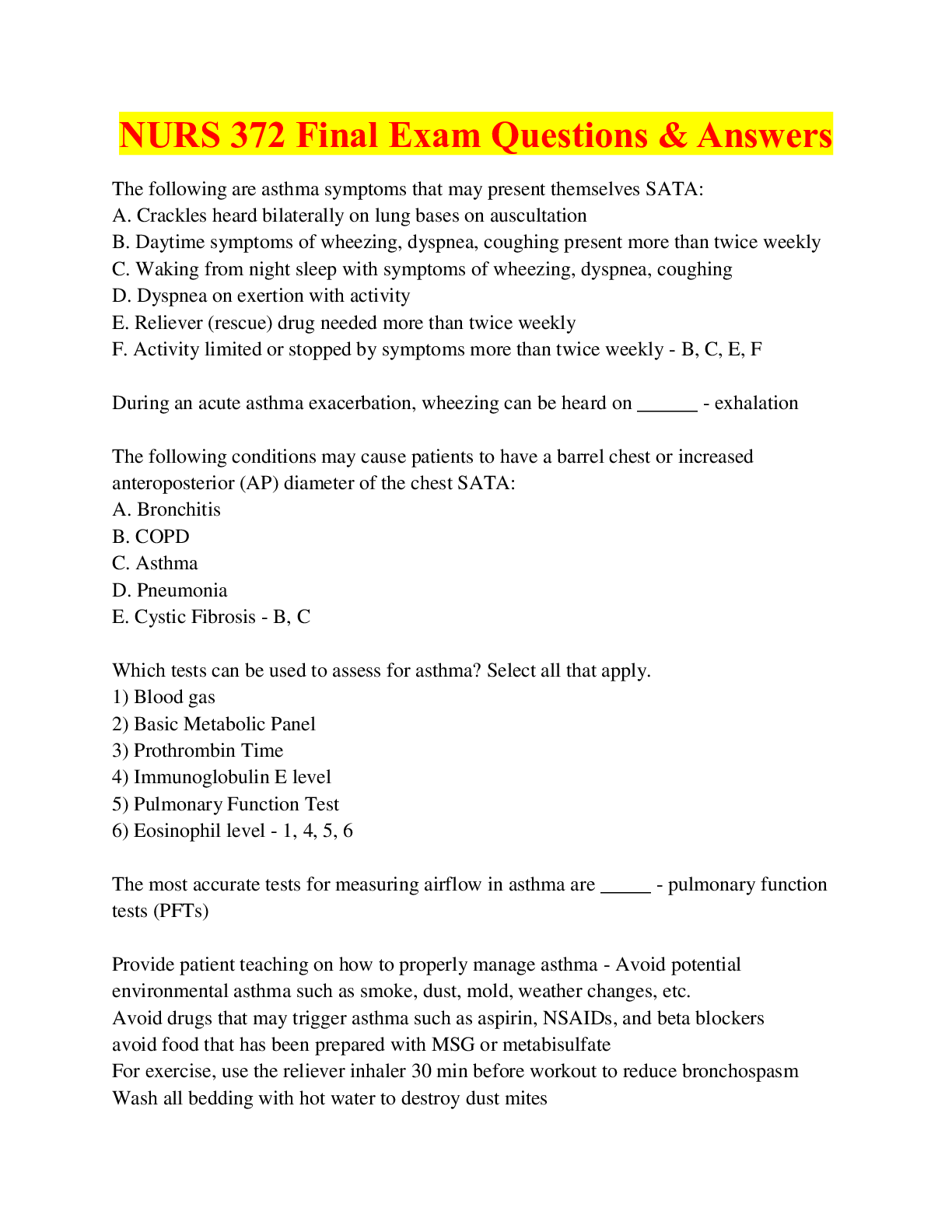
Buy this document to get the full access instantly
Instant Download Access after purchase
Add to cartInstant download
We Accept:

Reviews( 0 )
$12.50
Document information
Connected school, study & course
About the document
Uploaded On
Feb 25, 2024
Number of pages
33
Written in
Additional information
This document has been written for:
Uploaded
Feb 25, 2024
Downloads
0
Views
8






